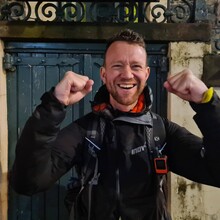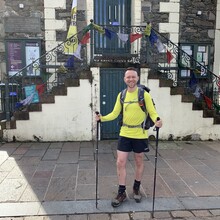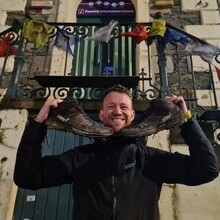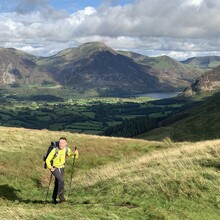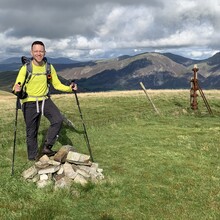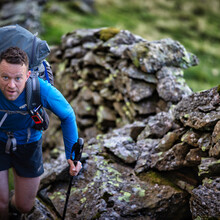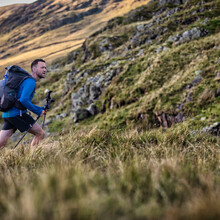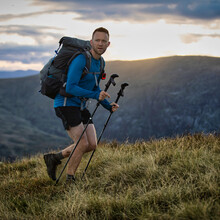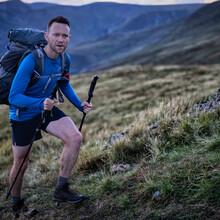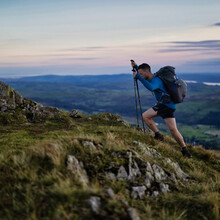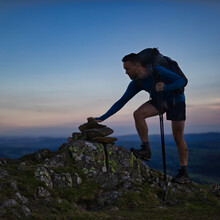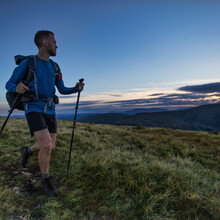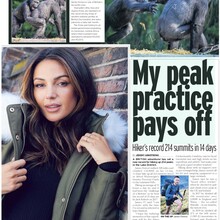HIKER SETS ‘SELF-SUPPORTED’ RECORD FOR 214-PEAK WAINWRIGHTS ROUND
A hiker has set an incredible new record time for a self-supported continuous hike of Alfred Wainwright’s 214 Lake District peaks.
James Forrest, 37, a journalist and adventurer from Cockermouth, Cumbria, walked 525km (328 miles) to complete the peak-bagging feat in 14 days and 11 hours.
The inov-8 ambassador ascended 36,000m - the equivalent height gain of four times Mount Everest
– and wild camped for 14 consecutive nights during the adventure.
Hiking alone with no support crew or pre-arranged help, James carried all his kit and camping equipment in a large rucksack. He occasionally re-supplied along the route with food and gas that he had earlier stashed in secret locations along the route.
The journalist and author hiked an average of 13 hours a day, battling all manner of brutal weather conditions. He wild camped amid the remote fells, and also slept overnight in a cave, a barn and a church.
It is the fastest self-supported completion, beating what is believed to be the previous record of 25 days, set by Jack Roberts in 2017.
James – a bored office worker turned intrepid adventurer who has set a number of mountain-bagging hike records across the UK and Ireland – said: “I am ecstatic with the time I’ve set and so relieved to have finished.
“The atrocious weather transformed the journey into a rather gruelling and traumatic experience – I’ve never felt so utterly miserable and unhappy on a mountain before. I thought the torrential rain and strong winds would never stop.
“But I’m so happy that I found the strength and resilience to keep going and make it to the finish line – it was really emotional arriving into Keswick, cheered on by friends and family. That moment will stay with me forever.
“It has been the challenge of a lifetime. I love the Lake District and – if I can somehow forget the thrashings I took from the weather gods – I hope the enduring memories of my expedition will be the times when the sun did shine and I relished the peace, beauty and escapism of Lakeland.
“The Lake District is a special place and we should all respect and look after it.”
James adhered to leave no trace principles during his trip, camping responsibly by carrying out all litter, never lighting fires, and pitching late and leaving early.
The fastest supported completion – and overall record – is held by inov-8 ultra runner Paul Tierney who, in June 2019, did it in a phenomenal 6 days, 6 hours and 5 minutes, beating Steve Birkinshaw’s previous best by almost 7 hours. As you would expect given the nature of their attempts, both runners were supported by pacers and a roadside support team.
James added: “I have a newfound respect for the ultra-runners who have run the Wainwrights in under a week – I have no idea how they got around so quickly.
“My approach was very different, however. Hiking alone and without a support crew added an extra layer of difficulty to my expedition, particularly the discomfort of camping in depressingly damp conditions after a long day of hiking.
“In some ways I loved the solitude and tranquillity – and I relished test of being entirely self-reliant. But dealing with the rather crushing mental lows by myself was incredibly difficult. There were a few times when I was in tears, ready to quit and throw in the towel, but I managed to pull through.
“I hope my journey has inspired some people to seek out the mountains and adventures in the great outdoors – they can have a massively beneficial impact on your mental health. Just make sure you pick a good weather window!”
James followed the route Steve Birkinshaw had meticulously planned in 2014, and which Paul also used. Starting and finishing in Keswick, it wriggles a way over the 214 summits famously featured in Alfred Wainwright’s iconic seven-volume pictorial guide to the Lakeland fells.
James added: “Steve’s route is incredibly clever and efficient – and I thank him for sharing it with me. He even came to see me on Blencathra and that was a lovely moment that really gave me a boost when I needed it.”
Throughout the adventure James wore just one pair of hiking boots, the ROCLITE G 345 GTX with Graphene-Grip, designed by Lake District born-and-based brand inov-8.
Lee Procter, inov-8 Global Communications & Ambassadors Manager, said: “It was a case of Hike, Forrest, Hike! What James achieved is amazing. He got to grips with some of England’s toughest hiking terrain, moving fast over it every day for almost 3 weeks. He has banked up many stories from this epic solo adventure and we can’t wait to hear them all.”
James Forrest previously completed a triple-crown of peak-bagging expeditions covering 1,001 peaks across the UK and Ireland. In 2017 he climbed all 446 mountains over 2,000ft in England and Wales – the so-called ‘Nuttalls’ – in just six months, the fastest ever time. He repeated the feat in 2018, bagging all 273 600m mountains in Ireland and Northern Ireland, known as the ‘Vandeleur-Lynams’, in just eight weeks, another record. And he finally completed his 1,001-mountain challenge by bagging all 282 ‘Munros’, mountains over 3000ft in Scotland, in 2019.
James is the author of Mountain Man: 446 Mountains. Six Months. One record-breaking adventure, published by Bloomsbury.
In answer to your specific questions:
1. Did I run/walk with anyone? No - my entire trip was solo.
2. Did you resupply with food? Yes, I resupplied via stash boxes I had left across the Lake District in advance.
3. Where did I get water? Filling up in streams.
4. More details on self-supported approach: I made a conscious effort to ensure my adventure was as authentically self-supported as possible. My aim was to be as self-reliant and self-sufficient as possible, and to genuinely survive alone in the mountains. I believe I achieved this aim by: wild camping or bivvying every night; cooking my own food every night (I didn't use any pubs, restaurants or cafes); walking alone; and re-supplying exclusively via stash boxes, rather than going to shops or supermarkets.
Here are two magazine article I wrote about my challenge:
The Great Outdoors magazine - published in December 2020 issue
I feel like a puppet, bereft of any control over my destiny. I am powerless and paralysed, entirely vulnerable to the capricious whim of the puppeteer. My strings are pulled and I obey. Whether I like it or not, I dance to the puppeteer’s tune. If he wants me to be happy, I frolic in the sunshine. If he decrees I should suffer, then I’m tortured by apocalyptic storms.
My puppeteer is a great story-teller, a spinner of captivating tales. This one is of a solitary hiker’s epic quest to summit all 214 Wainwright fells in a self-supported, non-stop round. The narrative is polarised: light and dark, good and evil, joy and tragedy. There is no in-between. The puppet master is not interested in the boring or mundane. He desires his puppet protagonist to experience the extremes and to exist on the edge. Dizzying highs and crushing lows. Halcyon days of sunshine and soul-crushing squalls. That is to be my fate.
The Greeks would call this puppeteer Zeus; the Romans prefer Jupiter and in Norse mythology it’s Thor. For me it is simply the weather god – a fickle, almost schizophrenic, deity with the power to bless you with immaculate blue skies and warming sunshine, or torment you with biblical downpours and terrifying winds. Saviour and captor, all in one.
Such is the lottery of hill-walking. You roll the dice and hope for the best – but the inescapable truth is that you’re not in control. Boom or bust. Joy or misery. Sun-drenched utopia or rain-battered dystopia. It can go either way - or flit between the two with an erratic unpredictability. One minute it’s hazy golden light, the next it’s ominous black skies; one minute you’re warm and dry, the next it’s deafening downpours and a biting sub-zero wind. All it takes is a flick of the wrist, or a twinkle of the fingers, from the puppeteer and you’re dancing to a different tune. Will he be cruel or kind?
Of course you can mitigate the risks by checking the forecast and picking your battles wisely. You can adopt a fair-weather-only strategy, or pragmatically change your goals at the first sight of grey clouds. But, for me, that’s not possible. Annual leave is booked, the route is long and the approach is committing. Once I’ve started it’s either quit or complete. There can be no days off or no plan Bs. Like anyone who has taken on a long-distance trail, I am exposed and unguarded. Whatever the puppeteer dictates, I must accept.
I am attempting to summit all 214 Wainwright fells in the Lake District in a continuous, self-supported hike. Alone and unaided, I must tramp 530km, ascend 36,000m - the equivalent height of four Everests – and wild camp every night for at least a fortnight. I must be entirely self-reliant, pitching my own tent, cooking my own camp meals and nursing my own wounds, both physical and mental. I must carry everything I need on my back, re-supplying every few days via stash boxes I previously cached in churches, farmers’ barns and pub outbuildings around the Lakes. And I must finish in 25 days or faster to achieve my ultimate goal of breaking the record for a self-supported Wainwrights round.
It is a self-chosen mission. The antidote to the lockdown-induced cabin fever and wanderlust in my system; and my chance to re-connect with the Lake District mountains I’ve longed for during an unsettling and frightening year defined by a deadly pandemic. I want the mountains to cleanse my troubled mind. I want to taste escapism and freedom on my lips; to feel the adrenaline of an arduous physical challenge coursing through my veins; and to hear the silence of solitude. I want to climb so hard and so fast, I lose sight of my comfort zone and triumphantly smash through the barriers of my perceived limits. But these are my selfish desires, based on a rose-tinted vision of adventure. The puppeteer has different ideas. For there to be light, there must also be dark.
First comes the darkness. The skies rumble and roar with a vociferous anger. An ominous clag clings to everything it touches, like a virus spreading across the land, infecting life with its heavy, depressing aura. Torrential rain surges and seethes, falling vertically and horizontally and every other perceivable angle all at once, while the wind bays and barks with a rabid savagery. The mountains – so often alluring and graceful – have morphed into something monstrous. They feel terrifyingly inhospitable; dark and menacing and hell-bent of wreaking havoc. I am not welcome in this place of pain and anguish.
I text my girlfriend Nic. “I’m in hell. It has turned into a horror show. I regret this whole thing. I wish I’d never signed up for it.” I feel inconsolably miserable, tears welling up in my eyes. I’m shivering and wet to the bone. My determination and spirit has been sucked out of me, drained by three consecutive days of atrocious conditions. I’m torn between differing emotions. I half want to admit defeat and succumb to my tormentor; to let go of everything and curl up in the foetal position. But another part of me is apoplectic with rage and wired by a sense of injustice, ready to fight to the bitter death with the frenzied intensity and survival instinct of a man on the brink.
I’m not yet ready to wave the white flag – and opt for the latter approach. Like a rugby player bracing for a bone-crunching tackle, I lean into the wind and crack on towards Scafell. I walk precisely and deliberately, sturdy enough to not be knocked over by the 50mph gusts, but light enough to nimbly dodge boulders and negotiate the ankle-jarring terrain. A tough day lies ahead: 10 more Wainwrights, a further 25km and over 2,500m of ascent before a damp, windy night under canvas. It is a prospect that fills me with dread.
Being self-sufficient in the mountains is serving only to amplify my vulnerability. Part of it is mental. While ultra-runners like Sabrina Verjee, Paul Tierney and Steve Birkinshaw have big support crews assisting their attempts, I ride solo – without a friendly smile, motivational pep talk or banterous joke from a team-mate to lift my spirits when I need it most. I must face every inner demon - every self-doubt and every spiral of negativity - alone.
The other part is practical. Only the thinnest layers of Gore-Tex, or lightest of flysheets, protect me from the brutality of the outdoors. I never have the safety of a roof over my head: no restaurants, cafes or pubs, no cosy B&Bs or hotels, and no shops or supermarkets. Instead I sleep in a soggy tent, existing like a feral mountain nomad, unwashed, unkempt and increasingly unhinged. My 10kg backpack hinders my progress, like a weight pulling me down, and I rapidly lose the patience to cook proper food, surviving off snacks and makeshift meals requiring minimal effort to prepare. It is an exhausting approach.
Nine hours later and I’m cocooned in my Nordisk Telemark 1 ULW, pitched to the west of Cold Fell. Rain is lashing down and the tent is being thrown around like a helpless creature in the jaws of a bloodthirsty predator. I feel genuinely unhappy. I’m flirting with failure, seduced by the tantalising thought of simply walking out of the mountains and going home. But I try to stay stoic. As Marcus Aurelius, the great Stoic philosopher, put it: “You have the power over your mind – not outside events. Realise this, and you will find strength.” I cannot control the weather, so what’s the point in letting it dictate my mood? Instead I channel positive thoughts: the wave of love and support I feel from the outdoors community; the purity and authenticity of my mission; the blessing of being able to pursue my adventure dreams; and the glory waiting at the finish line. It’s not easy to be optimistic when you feel surrounded by a whirlwind of suffering, but one idea keeps me going above all else. Perhaps, just perhaps, the puppeteer will show mercy on me tomorrow?
I unzip my tent and wake to a different world, a better world. Darkness becomes light; evil gives way to good; torment replaced by joy. The roulette wheel has spun – and this time I’ve been lucky. The skies are blue and the sun is rising over the horizon. The mountains are no longer uninviting and sinister; instead they look compassionate and warm-natured, welcoming intrepid souls into their inner sanctum to share in their riches. Today will be a good day.
Dawn is breaking, as I hike over Hard Knott and descend south aiming for Harter Fell and Green Crag. Eskdale is slowly coming to life, re-animated by the gentle touch of daylight. Meandering, haphazardly-wobbly dry stone walls segment the landscape into a crooked, asymmetrical puzzle of green fields. Whitewashed farm buildings hint to the land’s agricultural heritage and proud culture. A quad bike trundles through one field; a Border Collie perched on the back, a trusted steed to the flat-capped farmer, as Herdwicks flock together, moving as one like a murmuration of starlings. Above it all, pyramidal peaks - roughcast with a craggy surface of grey rocks - tower majestically. Wordsworth’s poetic words - “the loveliest spot that man hath found” – spring to mind.
I spend the morning veering east, over a no man’s land linking Eskdale to the Coniston Fells, before passing a sun-drenched afternoon bagging Dow Crag, The Old Man of Coniston, Brim Fell, Grey Friar, Great Carrs, Swirl How and Wetherlam. My route is intricate and complex, zig-zagging this way and that to tick off tops in the most efficient way. Designed by Steve Birkinshaw for his record-breaking round in 2014, it is a fellrunners’ route: direct and steep and uncompromising. But I enjoy the minimalism and routine of it all. Another day, another set of fells to climb. There is a wonderful simplicity to this back-to-basics existence.
The sunshine does wonders for my frame of mind too. It’s as if I have adventure bi-polar, my mood entirely in sync with the prevailing weather. The sun shines and I’m happy; rain falls and so does my morale and self-confidence. But today there is only an upward trend. My anxieties about the road ahead and fears of failure float away. A fog of negativity lifts and instead my mood is restored. I feel happy and content; rejuvenated and reborn, and ready for the fight around the corner. Nothing will stop from completing this journey. I am stronger than my enemies. I will prevail.
I descend Wetherlam Edge, loop to Low Tilberthwaite and ascend yet again – for what feels like the hundredth time today - to camp on Holme Fell. I pitch my tent and boil up a hot chocolate, as the sun sets over the handsome Langdale Pikes skyline. I feel a deep and intimate connection to the Lakeland landscape. Grass caresses the soles of my bare feet and a gentle breeze cools my cheeks. I know this moment is fleeting. The future is unwritten. Be it triumph or defeat, sunshine or storms, an uncertain journey lies ahead. I am merely a puppet, dancing to the puppeteer’s tune – and that’s ok.
British Mountaineering Council Summit magazine - published in Autumn 2020 issue
Tears are pouring down my cheeks, dripping onto the grimy rocks of Kidsty Pike’s cairn. I’m inconsolably miserable. Why the hell did I ever sign up for this godforsaken expedition to climb all 214 Wainwrights in a single round? I’m teetering on the brink of surrender. I just want the torment to end.
I’m cold, wet, exhausted and bereft of any fight. Several brutal rounds against the fearsome Cumbrian weather have left me battered and bruised – and emotionally beaten. I’ve been floored by a punishing right hook from the raging wind; almost KO-ed by a mighty jab from the torrential rain. Do I have the strength to get up off the canvas and face my formidable opponents yet again? Is this an unfair match, a battle I simply cannot win? I feel despairingly low and deeply unhappy. My fingers hover over my phone. Just a few clicks and I could put an end to this nightmare. Should I do it?
I pause – and think. The wind is gusting with a merciless wrath and horizontal rain is pummelling into my face like a thousand tiny daggers. I still have 15km and six Wainwrights to climb today to the east of Martindale. Then I’ve got to sleep in my tent amid these apocalyptically atrocious conditions. And then I’ve got to continue for 213km for the next four or five days, over 76 more Wainwrights and double the height of Everest. It’s a horrible prospect; one that knots my stomach and scrambles my brain with anxiety and desperation. I open up WhatsApp. “I’m done...can you collect me?”
But I delete the message. I stand up, tighten my hood around my face, brace against the wind and head off into the clag towards High Raise, my next Wainwright. A sense of euphoria gradually descends over me. There is something intoxicatingly uplifting about reaching rock bottom - staring into the abyss of failure – and pulling through. I feel invincible. Nothing will now stop me from reaching the finish line.
I walk hard and fast. Fury is coursing through my veins. I am apoplectic at the weather gods, as if I’ve suffered a great injustice. But the anger is no longer a negative chain around my neck, pulling me into a downward spiral of negativity. Instead, like a sportsperson who performs better when angry, I am harnessing it for something positive, using it to fuel my fire and rekindle my spirit. I will not let the weather win. I will not let all those hard miles, gruelling ascents and mental battles be for nought. I will not accept defeat.
I write a narrative in my own head. My epic quest – to hike up all 214 Wainwrights in the fastest ever self-supported round – has become a war of attrition. I have only one simple weapon in this bloody conflict: to methodically chip away at the route’s 530km and 36,000m of ascent. My three nemeses – the weather, the mountains and my mind – however possess a far more complex and intricate arsenal.
The weather wields terrifying force, like a cruel monster hell bent on inflicting pain and misery on its victim; whereas the mountains are more like a siren, seductively luring you in with their beauty and majesty, only to cripple you with infuriatingly never-ending ascents, ankle-jarringly rough terrain, and knee-crushing descents. But, worse still, is the enemy in my own head. It’s the wiliest and most cunning of opponents. It can blind you with self-doubt; paralyse you with negative thinking; and torture you with tantalising thoughts of how easy it’d be to give up.
The latter has been a thorn in my side for the past week or so. It’s day 10 of my peak-bagging adventure. 10 days of solitude. 10 days of being alone with the thoughts in my head. 10 days of singlehandedly facing my demons. My chosen mission is to complete a single, non-stop, self-supported round of all 214 Wainwrights. This approach serves only to exacerbate the psychological challenge. While the ultra-runners have big support crews assisting their attempts, I am a Lone Ranger. I have no team-mates or comrades to lift me out of the mental mire; no friendly faces to perk me up with a joke or smile when I need it most.
I walk solo. I’m self-reliant. I carry everything I need on my back, re-supplying every few days via stash boxes I previously cached in churches, farmer’s barns and pub outbuildings around the Lakes. I pitch my own tent, cook my own camp meals, filter my own water, nurse my own wounds and massage my own aches. Ten two-letter words sum it up: if it is to be, it is up to me.
This is exactly how I want it to be. I’m no runner. I’ve never run a marathon, let alone an ultra. Tierney, Birkinshaw and Verjee would easily leave me in their wake. But I am trying something different and unique, something that suits my skill-set – to survive in the mountains, alone and unaided. It feels like an authentic, ‘purist’ and intrepid approach. No restaurants, cafes or pubs. No cosy B&Bs or hotels. No shops or supermarkets. Just a real, back-to-basics adventure. One man versus the mountains.
But, in awful weather, it feels like a wretched approach. Every aspect of being self-supported feels like an extra chore and hassle, eroding my patience and amplifying the suffering. My 10kg backpack weighs me down and slows my progress. Sleeping in a rain-lashed, wind-battered tent is hardly conducive to restful recuperation, while the morning routine of slipping my blistered feet into wet socks is a sickeningly vulgar daily errand. At times, I’m so tired I just can’t muster up the energy to cook, settling for cold porridge for dinner instead; and the constant hardships of a feral existence – not washing, performing toilet duties (responsibly) in the wild, rarely feeling warm or dry - are utterly draining.
I hike north along the broad, boggy ridge towards Wether Hill and Loadpot Hill, face down, marching robotically. The wind is buffeting my jacket and the drizzly air is saturated, as if I’m walking through a cloud. I let my mind wander to better times. It hasn’t all been a suffer-fest. I enjoyed four days of joyously sunny weather in the middle of my trip. I always wanted my round to strike a tricky balance: to be an arduous physical challenge that pushed my boundaries and tested my limits, but also served up the spiritual joys - freedom, escapism, nature, tranquillity – of the mountains. And on those sunny, dry days I walked that tightrope effectively.
On Holme Fell, I sat in the porch of my tent, tucking into a hearty expedition meal from Base Camp Food, and watched the sky morph into ever-changing, diluting, blending hues of pink, orange and red above the jagged profile of the Langdale Pikes. On the ridges around Grasmere, I relished the simplicity of my only goal for the day being to walk from A to B; and on the Fairfield fells the beauty of Lakeland – that magical place of wobbly dry stone walls, sweeping ridges, craggy buttresses, towering summits, tumbling ghylls, glistening lakes and placid Herdwicks – induced me into a coma of mindless happiness. Anxieties floated away, my mood restored and I felt rejuvenated.
A blast of wind and rain transports me back to the far less appetising present. My Inov-8 Roclite G 345 GTX boots trudge through wet ground towards Arthur’s Pike, above Ullswater, as a cold raindrop trickles down my spine. I shiver and decide to pick up the pace, planting my poles deliberately and purposefully. I think about my journey so far. What will it be like to reach the finish line? Will the sense of achievement at the end make all the hardship and suffering worth it? And, most of all, what have I learnt from this adventure?
I’m troubled by the thought that the mountains have become the source of, rather than solution to, my problems. Perhaps the great epiphany – the ultimate learning point – of my quest is that the mountains are in charge. They are to be respected, and feared, and only taken on with humility. As much as they can be therapeutic and healing; they can also be brutally inhospitable, places of pain and anguish and unhappiness. But I don’t want this entire mission to boil down to “don’t go in the mountains when it’s raining”. That feels like an unsatisfactory conclusion.
But maybe this whole journey isn’t just about the mountains? Maybe it’s about life in general? The mountains are a microcosm of an everyday existence; a mirror-image of reality. The rain and wind and exhausting ascents are symbolic. They represent the cruel twists and heartbreaking turns of life; the obstacles and frustrations and unkindnesses we all face, day in day out. You can either let those trials and tribulations defeat you; or you can conquer them. And I’m suddenly struck by an inspiring, elevating thought – a truly satisfactory conclusion to my adventure. If I can overcome the challenges of the mountains with resilience and positivity, perhaps I can do the same with everyday life.

